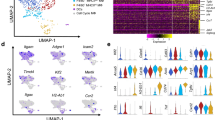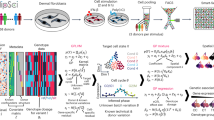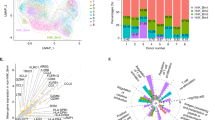Abstract
Recent molecular studies have shown that, even when derived from a seemingly homogenous population, individual cells can exhibit substantial differences in gene expression, protein levels and phenotypic output1,2,3,4,5, with important functional consequences4,5. Existing studies of cellular heterogeneity, however, have typically measured only a few pre-selected RNAs1,2 or proteins5,6 simultaneously, because genomic profiling methods3 could not be applied to single cells until very recently7,8,9,10. Here we use single-cell RNA sequencing to investigate heterogeneity in the response of mouse bone-marrow-derived dendritic cells (BMDCs) to lipopolysaccharide. We find extensive, and previously unobserved, bimodal variation in messenger RNA abundance and splicing patterns, which we validate by RNA-fluorescence in situ hybridization for select transcripts. In particular, hundreds of key immune genes are bimodally expressed across cells, surprisingly even for genes that are very highly expressed at the population average. Moreover, splicing patterns demonstrate previously unobserved levels of heterogeneity between cells. Some of the observed bimodality can be attributed to closely related, yet distinct, known maturity states of BMDCs; other portions reflect differences in the usage of key regulatory circuits. For example, we identify a module of 137 highly variable, yet co-regulated, antiviral response genes. Using cells from knockout mice, we show that variability in this module may be propagated through an interferon feedback circuit, involving the transcriptional regulators Stat2 and Irf7. Our study demonstrates the power and promise of single-cell genomics in uncovering functional diversity between cells and in deciphering cell states and circuits.
This is a preview of subscription content, access via your institution
Access options
Subscribe to this journal
Receive 51 print issues and online access
$199.00 per year
only $3.90 per issue
Buy this article
- Purchase on Springer Link
- Instant access to full article PDF
Prices may be subject to local taxes which are calculated during checkout




Similar content being viewed by others
Change history
12 June 2013
Minor changes were made to the spelling of authors S.S. and J.J.T. Also, an accession number for GEO was added.
References
Bengtsson, M. Gene expression profiling in single cells from the pancreatic islets of Langerhans reveals lognormal distribution of mRNA levels. Genome Res. 15, 1388–1392 (2005)
Raj, A. & Van Oudenaarden, A. Single-molecule approaches to stochastic gene expression. Ann. Rev. Biophys. 38, 255–270 (2009)
Kalisky, T., Blainey, P. & Quake, S. R. Genomic analysis at the single-cell level. Ann. Rev. Gen. 45, 431–445 (2011)
Feinerman, O. et al. Single-cell quantification of IL-2 response by effector and regulatory T cells reveals critical plasticity in immune response. Mol. Sys. Biol. 6, 1–16 (2010)
Cohen, A. A. et al. Dynamic proteomics of individual cancer cells in response to a drug. Science 322, 1511–1516 (2008)
Bendall, S. C. et al. Single-cell mass cytometry of differential immune and drug responses across a human hematopoietic continuum. Science 332, 687–696 (2011)
Islam, S. et al. Characterization of the single-cell transcriptional landscape by highly multiplex RNA-seq. Genome Res. 21, 1160–1167 (2011)
Tang, F. et al. mRNA-Seq whole-transcriptome analysis of a single cell. Nature Methods 6, 377–382 (2009)
Ramskold, D. et al. Full-length mRNA-Seq from single-cell levels of RNA and individual circulating tumor cells. Nature Biotech. 30, 777–782 (2012)
Hashimshony, T., Wagner, F., Sher, N. & Yanai, I. CEL-Seq: single-cell RNA-seq by multiplexed linear amplification. Cell Rep. 2, 666–673 (2012)
Tay, S. et al. Single-cell NF-κB dynamics reveal digital activation and analogue information processing. Nature 466, 267–271 (2010)
Amit, I. et al. Unbiased reconstruction of a mammalian transcriptional network mediating pathogen responses. Science 326, 257–263 (2009)
Li, G.-W. & Xie, X. S. Central dogma at the single-molecule level in living cells. Nature 475, 308–315 (2011)
Li, B. & Dewey, C. N. RSEM: accurate transcript quantification from RNA-Seq data with or without a reference genome. BMC Bioinformatics 12, 323 (2011)
Bar-Even, A. et al. Noise in protein expression scales with natural protein abundance. Nature Genet. 38, 636–643 (2006)
Garber, M. et al. A high-throughput chromatin immunoprecipitation approach reveals principles of dynamic gene regulation in mammals. Mol. Cell 47, 810–822 (2012)
Sigal, A. et al. Variability and memory of protein levels in human cells. Nature 444, 643–646 (2006)
Katz, Y., Wang, E. T., Airoldi, E. M. & Burge, C. B. Analysis and design of RNA sequencing experiments for identifying isoform regulation. Nature Methods 7, 1009–1015 (2010)
Kivioja, T. et al. Counting absolute numbers of molecules using unique molecular identifiers. Nature Methods 9, 72–74 (2012)
Waks, Z., Klein, A. M. & Silver, P. A. Cell-to-cell variability of alternative RNA splicing. Mol. Syst. Biol. 7, 1–12 (2011)
Gurskaya, N. G. et al. Analysis of alternative splicing of cassette exons at single-cell level using two fluorescent proteins. Nucleic Acids Res. 40, e57 (2012)
Jiang, A. et al. Disruption of E-cadherin-mediated adhesion induces a functionally distinct pathway of dendritic cell maturation. Immunity 27, 610–624 (2007)
Friedman, N. Inferring cellular networks using probabilistic graphical models. Science 303, 799–805 (2004)
Ning, S., Huye, L. E. & Pagano, J. S. Regulation of the transcriptional activity of the IRF7 promoter by a pathway independent of interferon signaling. J. Biol. Chem. 280, 12262–12270 (2005)
Zhao, M., Zhang, J., Phatnani, H., Scheu, S. & Maniatis, T. Stochastic expression of the interferon-β gene. PLoS Biol. 10, e1001249 (2012)
Rand, U. et al. Multi-layered stochasticity and paracrine signal propagation shape the type-I interferon response. Mol. Syst. Biol. 8, 584 (2012)
Änkö, M.-L. et al. The RNA-binding landscapes of two SR proteins reveal unique functions and binding to diverse RNA classes. Genome Biol. 13, R17 (2012)
Sachs, K., Perez, O., Pe’er, D., Lauffenburger, D. A. & Nolan, G. P. Causal protein-signaling networks derived from multiparameter single-cell data. Science 308, 523–529 (2005)
Cabili, M. N. et al. Integrative annotation of human large intergenic noncoding RNAs reveals global properties and specific subclasses. Genes Dev. 25, 1915–1927 (2011)
Cai, L., Dalal, C. K. & Elowitz, M. B. Frequency-modulated nuclear localization bursts coordinate gene regulation. Nature 455, 485–490 (2008)
Acknowledgements
We thank N. Chevrier, C. Villani, M. Jovanovic, M. Bray and J. Shuga for scientific discussions; N. Friedman and E. Lander for comments on the manuscript; B. Tilton, T. Rogers and M. Tam for assistance with cell sorting; J. Bochicchio, E. Shefler and C. Guiducci for project management; the Broad Genomics Platform for all sequencing work; K. Fitzgerald for the Irf7−/− bone marrow; and L. Gaffney for help with artwork. Work was supported by a National Institutes of Health (NIH) Postdoctoral Fellowship (1F32HD075541-01, to R.S.), a Charles H. Hood Foundation Postdoctoral Fellowship (to A. Goren), an NIH grant (U54 AI057159, to N.H.), an NIH New Innovator Award (DP2 OD002230, to N.H.), an NIH CEGS Award (1P50HG006193-01, to H.P., A.R. and N.H.), NIH Pioneer Awards (5DP1OD003893-03 to H.P., DP1OD003958-01 to A.R.), the Broad Institute (to H.P. and A.R.), HHMI (to A.R.), and the Klarman Cell Observatory at the Broad Institute (to A.R.).
Author information
Authors and Affiliations
Contributions
A.R., H.P., J.Z.L., N.H., A.K.S., R.S., A. Goren and A. Gnirke conceived and designed the study. A.K.S., X.A., R.S.G., J.T.G., R.R., C.M., D.L., J.J.T., D.G. and J.T.G. performed experiments. R.S., A.K.S., S.S. and N.Y. performed computational analyses. R.S., A.K.S., A. Goren, N.H., J.Z.L., H.P. and A.R. wrote the manuscript, with extensive input from all authors.
Corresponding authors
Ethics declarations
Competing interests
The authors declare no competing financial interests.
Supplementary information
Supplementary Information
This file contains a Supplementary Discussion, Supplementary Methods, Supplementary Figures 1-20 and additional references. (PDF 5465 kb)
Supplementary Data
This zipped file contains Supplementary Tables 1-7. Supplementary Table 1 shows sequencing metrics for single cell, population, and molecularly barcoded RNA-seq libraries. Supplementary Table 2 shows transcript per million (TPM) levels for all UCSC genes (rows) for 18 single cells and 3 population replicates (columns), along with annotation of which genes are 'Housekeeping' and which are 'LPS Response'. Supplementary Table 3 shows single cell variability measures for 523 highly expressed (population average) genes, along with annotation of which genes are 'Housekeeping' and which are 'LPS Response'. Supplementary Table 4 shows percent spliced in (PSI) estimates for all genes that are very highly expressed (TPM>250) in at least one single cell, only PSI estimates for the highly expressing cells were used to generate Figure 3b (see Supplementary Information file). Supplementary Table 5 shows clustering assignments and principal component scores for 633 genes induced in response to LPS stimulation. Supplementary Table 6 contains gene list and PCR primer pairs used for the Fluidigm single cell qPCR codeset. Supplementary Table 7 contains TPM estimates and unique molecular identifier counts for each gene in the 3 libraries prepared using the modified SMARTer protocol. (ZIP 4525 kb)
Rights and permissions
About this article
Cite this article
Shalek, A., Satija, R., Adiconis, X. et al. Single-cell transcriptomics reveals bimodality in expression and splicing in immune cells. Nature 498, 236–240 (2013). https://doi.org/10.1038/nature12172
Received:
Accepted:
Published:
Issue Date:
DOI: https://doi.org/10.1038/nature12172
This article is cited by
-
High-throughput single nucleus total RNA sequencing of formalin-fixed paraffin-embedded tissues by snRandom-seq
Nature Communications (2023)
-
Clinical-mediated discovery of pyroptosis in CD8+ T cell and NK cell reveals melanoma heterogeneity by single-cell and bulk sequence
Cell Death & Disease (2023)
-
The role of serum amyloid A1 in the adipogenic differentiation of human adipose-derived stem cells basing on single-cell RNA sequencing analysis
Stem Cell Research & Therapy (2022)
-
Smart software untangles gene regulation in cells
Nature (2022)
-
Executable models of immune signaling pathways in HIV-associated atherosclerosis
npj Systems Biology and Applications (2022)
Comments
By submitting a comment you agree to abide by our Terms and Community Guidelines. If you find something abusive or that does not comply with our terms or guidelines please flag it as inappropriate.



